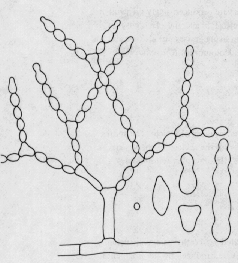Main page <> Index of descriptions <> Previous description <> Chrysonilia <> Next description

Chrysonilia
Recognized by its branched chains of light or brightly coloured spores (conidia) arising from inconspicuous conidiophores. Spores are produced by "budding", with the youngest ones at the tips of the chains.
Species of Chrysonilia, including C. sitophila, the red bread mould, produce very fast growing pink colonies and numerous spores. The spores are dry and easily detached from one another. Because they combine rapid growth and prolific reproduction, species of Chrysonilia can contaminate other laboratory cultures very rapidly. In the school or university laboratory where many students may be cultivating fungi at the same time these fungi can cause lab-wide epidemics, ruining every culture they contact. The best strategy is to discard all rapidly growing, pink, powdery cultures without opening them.
Neurospora, the holomorph of Chrysonilia species, is widely used as an experimental organism. More is known about the physiology and genetics of Neurospora than any other fungus. The ascospores of Neurospora species resist germination until they encounter certain kinds of physical or chemical stimulant. In nature, the ascospores occur in soil and are activated by heat. Thus the species Neurospora and their associated Chrysonilia anamorphs can often be found on the surface of soil following forest or grass fires. They can also appear on the surface of soil that has been partially sterilized in the greenhouse. They can be isolated from soil by first treating the sample with alcohol or heat (see discussion of stress techniques in Chapter 4.
Many texts still treat Chrysonilia species in the genus Monilia. However, Monilia species are plant parasites, commonly causing a soft brown rot of stone fruits (peaches, apricots, etc.), and are not closely related to Chrysonilia. Common in soil, homes, fruits, and as a laboratory pest..
Classification: Sordariaceae (Sordariomycetidae). Holomorph: Neurospora. Ref: Samson et al, 2004.